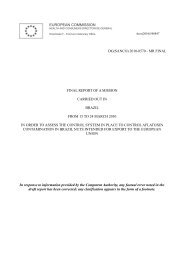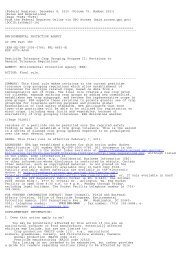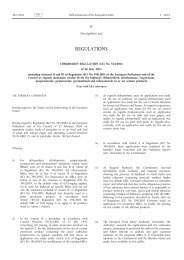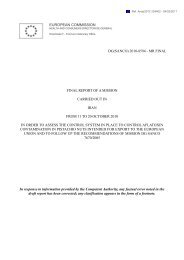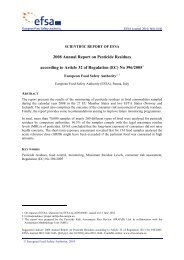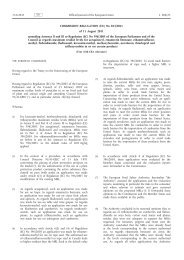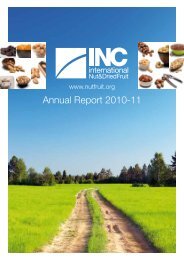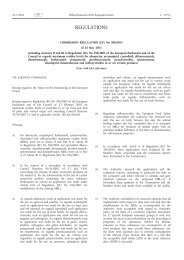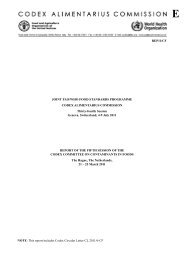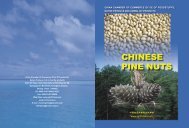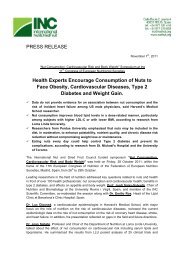REP11/PR JOINT FAO/WHO FOOD STANDARDS PROGRAMME ...
REP11/PR JOINT FAO/WHO FOOD STANDARDS PROGRAMME ...
REP11/PR JOINT FAO/WHO FOOD STANDARDS PROGRAMME ...
Create successful ePaper yourself
Turn your PDF publications into a flip-book with our unique Google optimized e-Paper software.
<strong>REP11</strong>/<strong>PR</strong> 11<br />
103. The Committee noted that the working group had produced two revised documents as contained in CX/<strong>PR</strong> 11/43/7 (Principles<br />
and Guidance including Table 1) and CX/<strong>PR</strong> 11/43/8 (Addenda). The Committee also noted that the two items were correlated and<br />
agreed to discuss them together. The Delegation of the United States of America introduced both documents and gave a brief<br />
summary of the main outcome of the discussions in the working group. In this regard, it was noted that Table 1 had been revised by<br />
including fruit commodity groups with a view to facilitating the finalization of the Principles/Guidance and Table 1 (fruit types) at the<br />
next session of the Committee vis-à-vis the corresponding fruit commodity groups in the Classification of Foods and Animal Feeds<br />
and the decision of the 42 nd Session of the Committee that, if all fruit types were completed by 2012, consideration would be given to<br />
advancing them to Step 8 for final adoption by the Commission and inclusion in the Classification of Foods and Animal Feeds 14 .<br />
104. The Committee agreed that Table 1 should be an integral part of the final document. However, the information contained in<br />
the Addenda was considered useful supportive information for the development of Table 1 (Addendum I) and to provide background<br />
information on the development of the document (Addendum II) but they should not be part of the final document. The Committee<br />
noted that this information was available in the reports and relevant working documents prepared for the discussion of this item at<br />
different sessions of the Committee and that Codex documents were available for consultation on the Codex website. As a result, the<br />
Committee agreed to delete or adjust all references to Addenda I and II in the document.<br />
105. The Committee noted that the reference to “similar (as opposed to same) use pattern or GAP” for the selection of<br />
representative commodities covered by a group MRL was entered to provide for some degree of flexibility in the application of the<br />
Principles and that this term was limited to the relevant provisions provided for in the <strong>FAO</strong> Manual on the Submission and Evaluation<br />
of Pesticide Residue Data for the Estimation of Maximum Residue Level in Food and Feed.<br />
Consideration of the Principles and Guidance<br />
106. The Committee made a number of amendments by removing or transferring some provisions to other sections as not<br />
necessary or more relevant for the given section.<br />
107. The Delegation of the EU noted that extrapolation of results of residue trials is a possibility to establish MRLs for<br />
crops/commodities for which the number of trials would not be sufficient to derive individual MRLs. However, the setting of MRLs by<br />
extrapolation introduced an additional source of uncertainty. Therefore, extrapolation should be restricted to cases where the GAP<br />
was comparable and similar residue behaviour was expected. If available residue trials demonstrated that the use of a pesticide<br />
would result in different residue concentrations in the crops belonging to the same crop group, it is preferable to derive individual<br />
MRLs instead of extrapolating the highest MRL calculated for the crop with the highest residue to the other members of the<br />
commodity group. In these cases, the ALARA Principles should be applied to set MRLs at appropriate lower levels. Based on this<br />
consideration, the Committee agreed to introduce a reference to the ALARA Principles when considering representative commodity<br />
to extrapolate to other members of a commodity group.<br />
Consideration of Table 1<br />
108. The Committee agreed to change the title to more appropriately reflect the purpose of and information contained in Table 1. In<br />
Group 001 Citrus Fruits, the Committee agreed that, in order to extrapolate maximum residue limits for pesticides to the whole citrus<br />
fruits group (FC 0001), data should be provided on lemon or lime; and mandarin; and orange; and pummelo or grapefruit. In lemons<br />
and limes (FC 0002), the name of “yuzu” was changed to “yuja” for consistency with the discussion on this commodity under Agenda<br />
Item 7(b) (see para. 90).<br />
109. In Group 003 Stone Fruits, apricot was added as an alternative representative commodity to peach for extrapolation of MRLs<br />
to the whole stone fruits group (FP 0009) hence a consequential amendment was made to Subgroup 003C, Peaches. It was noted<br />
that in some countries apricot was the commodity most likely to contain the highest residues. It was however noted that peaches<br />
have large cultivation areas in many countries therefore the decision on which commodity would be considered as representative of<br />
the relevant group could be taken based on information provided on dietary consumption and/or production area.<br />
110. In Group 006 Assorted Tropical and Subtropical Fruits – inedible peel, the reference to “dragonfruit” was changed to<br />
“pitahaya” for consistency with Subgroup 006D, Assorted tropical and sub-tropical, inedible peel – cactus where pitahaya, as<br />
opposed to dragonfruit, was indicated as a representative commodity for inedible peel – cactus (FI 2024). Along these lines,<br />
“Spanish lime” was included in addition to “litchi” in the general Group 006 for consistency with Subgroup 006A, Assorted Tropical<br />
and Sub-tropical, inedible peel, small where Spanish lime was indicated as a representative commodity for inedible peel – small (FI<br />
2021). In this regard, the Committee agreed to include longans as a representative commodity in addition to litchi as they were<br />
similar to litchis in morphology, growth habit, pest problems, similar GAPs, and edible portion for the determination of the residue. In<br />
addition, longans produce similar or higher residues than litchis and were widely produced and traded within the Asian region.<br />
14 ALINORM 10/33/24, para. 104.



